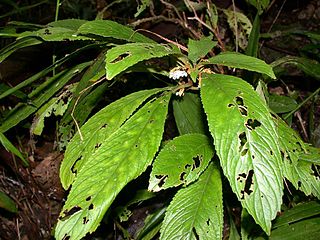Related Research Articles

Melicope is a genus of about 240 species of shrubs and trees in the family Rutaceae, occurring from the Hawaiian Islands across the Pacific Ocean to tropical Asia, Australia and New Zealand. Plants in the genus Melicope have simple or trifoliate leaves arranged in opposite pairs, flowers arranged in panicles, with four sepals, four petals and four or eight stamens and fruit composed of up to four follicles.

Alpinia is a genus of flowering plants in the ginger family, Zingiberaceae. Species are native to Asia, Australia, and the Pacific Islands, where they occur in tropical and subtropical climates. Several species are cultivated as ornamental plants.

Aeschynanthus is a genus of about 150 species of evergreen subtropical and tropical plants in the family Gesneriaceae. They are usually trailing epiphytes with brightly colored flowers that are pollinated by sunbirds. The genus name comes from a contraction of aischuno and anthos (flower). The common name for some species is lipstick plant, which comes from the appearance of the developing buds emerging from the calyces. A full list of the accepted species and their synonyms can be found in the Smithsonian Institution's World Checklist of Gesneriaceae.

Leea is a genus of plants in the family Vitaceae, subfamily Leeoideae, that are native to parts of central Africa, tropical Asia, Australia and Melanesia. It was previously placed in its own family, Leeaceae, based on morphological differences between it and other Vitaceae genera. These differences include ovule number per locule, carpel number, and the absence or presence of a staminoidal tube and floral disc. Pollen structure has also been examined for taxonomic demarcation, though studies have concluded that the pollen of Leeaceae and Vitaceae suggests the families should remain separate while other studies conclude that Leea should be included in Vitaceae.
Dischidia is a genus of plants in the “dog-bane” family Apocynaceae, collectively known as the “milkweeds”. They are epiphytes, native to tropical areas of China, India as well as Bhutan’s southern borders, wherever minimal frost occurs. Additionally, they are known from most areas of Mainland Southeast Asia, including forested areas of Myanmar, Thailand, Vietnam, Cambodia, Laos, and some parts of Indonesia, Malaysia and Singapore. Several species are also native to Papua New Guinea and northeastern Australia.

Polyosma is a genus of about 90 species of trees native to south-east Asia. They occur from China south through south-east Asia to the east coast of Australia, New Guinea, the Solomon Islands and New Caledonia.

Argostemma is a genus of flowering plants in the family Rubiaceae. It can be found in (sub)tropical Asia and western and west-central tropical Africa.

Rhynchoglossum is a genus of plant in family Gesneriaceae. In recent times, members of the former genus Klugia are also included. Species within the broader genus are found in India, southern China to New Guinea and about three species in tropical America. The genus has a leaf arrangement that is termed as alternate-distichous and the leaves are asymmetric in shape. The flowers have two lips. The older genus Klugia had four stamens compared to the typical two but Klugia from southern India are found to be very close based on molecular evidence.

Codonoboea is a genus of flowering plants in the family Gesneriaceae. It includes 129 species which range from Myanmar and Thailand through northern Malesia to New Guinea.

Agalmyla is a genus of plants in the family Gesneriaceae.

Epithema is a genus of plants in the family Gesneriaceae and subfamily Didymocarpoideae. Species range from western tropical Africa to Uganda, tropical and subtropical Asia, and New Guinea.

Rhynchotechum is a genus of plants in the family Gesneriaceae, subfamily Didymocarpoideae. Species distribution records are mostly from India, Sri Lanka, China through to southern Japan, Indo-China and Malesia through to New Guinea.
Paraboea are a genus of flowering plants in the African violet family Gesneriaceae, native to southern China, Assam, Indochina, and Malesia. They were recircumscribed from Boea in 2016.
References
- ↑ "Cyrtandra J.R.Forst. & G.Forst". Plants of the World Online. Board of Trustees of the Royal Botanic Gardens, Kew. 2021. Retrieved 10 December 2021.
- ↑ Atkins, Hannah J.; Bramley, Gemma L. C.; Clark, John R. (2013). "Current Knowledge and Future Directions in the Taxonomy of Cyrtandra (Gesneriaceae), with a New Estimate of Species Number". Selbyana. 31 (2): 157–165. JSTOR 24894287.
- ↑ Atkins, H. J.; Kartonegoro, A. (2021). "A Taxonomic Revision of Cyrtandra (Gesneriaceae) in Sulawesi, Indonesia". Edinburgh Journal of Botany. 78: 1–122. doi: 10.24823/EJB.2021.364 . S2CID 239680334.